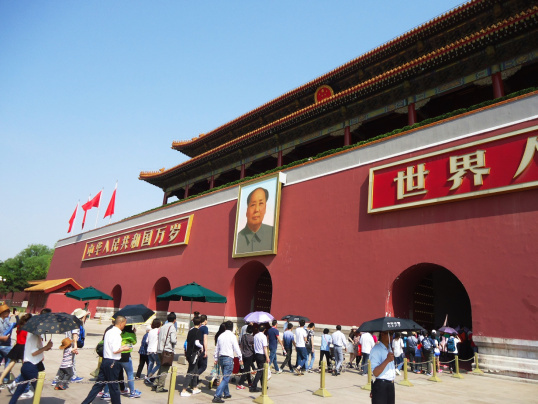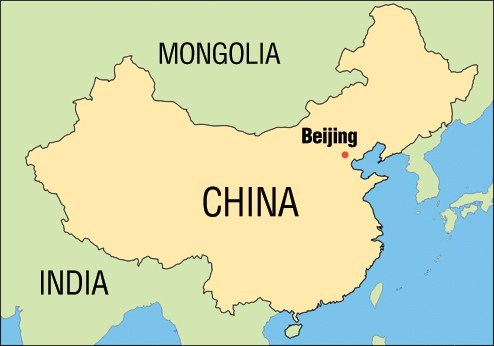A Beijing break
Beijing takes your breath away. Whether it’s Tiananmen Square, the Forbidden City, the Summer Palace or the Great Wall, everything’s on a grand scale. And it isn’t just the ancient monuments that are awesome. The Chinese capital has no fewer than six Unesco World Heritage sites and it has also wholeheartedly embraced modernisation. Ancient historical monuments stand cheek-by-jowl with futuristic constructions. The impact of fast-growth is visible everywhere and it’s all about being glitzier, bigger and bolder.

Chairman Mao’s mammoth poster on the Tienanmen Gate
I wasn’t prepared for the city’s magnitude, despite reading descriptions. From its sprawling airports to high-speed trains and lofty structures, everything’s outsized.
The stark image of the ‘Tank Man’ that went round the world during the Chinese students’ protests resurfaced in my mind as I ambled through gigantic, tightly protected, teeming Tienanmen Square. It was here that Chairman Mao declared the People’s Republic of China on October 1, 1949, and it’s also where he’s interred. Each sunrise and sunset, goose-stepping soldiers perform a flag-raising and lowering ritual.

The Tienanmen Gate — or Gateway of heavenly peace — is the entrance to the Forbidden City and I made my way through a crowd of selfie-seekers jostling for a snap against the backdrop of a huge image of Mao Zedong.

A sculpture of revolutionary struggle at Tienanmen Square.
The Forbidden City was everything I’d imagined — enormous and forbidding. It was home to a long line of emperors — from the Ming to the Qing Dynasty. Surrounded by a moat and beautiful gardens, it’s a gigantic complex. It’s impossible to see all the halls and gardens in a single day. But if you’ve only got time for one hall, head to the Hall of Supreme Harmony with its ornate Dragon Throne.

The Forbidden City
If you’ve a little time, stop by the Imperial Garden with its beautiful pavilions, walkways and water-bodies. I found myself calmed by the garden’s languorous ambience.
Later, I rushed to the Temple of Heaven, another UNESCO Heritage Site. Roughly three times the size of Forbidden City, it’s a sprawling and beautiful complex with a clutch of temples, halls and parks. This is where the emperors offered prayers for good harvests.
Right near the entrance I was delighted to hear a concert. The rambling parks here draw musicians from all walks of life.

Hall of Prayers at Temple of Heaven
Gnarled pine trees, some over 500 years old, form the forested foreground for the impressive Hall of Prayers. There are several places to halt like the circular Mound Altar, octagonal Imperial Vault of Heaven and the Echo Wall. Traversing the Long Corridor connecting the Divine Kitchen to the Hall of Prayers, I spied some senior citizens playing cards, while another group practiced music.
The Summer Palace, my next stop, was an enormous complex surrounded by the massive Kunming Lake and overlooked by Longevity Hill. Every imperial place is built on a colossal scale.

The 17 arch marble bridge at summer palace
Instead of walking around the lake for half a day, I opted for an enchanting boat ride to reach the palace hub. The main palace, built to serve as a summer retreat for the royals, has numerous ancient palaces that housed the emperor, queens and concubines. I was enchanted by the 17-arch marble bridge that spanned the lake and colourful wooden palaces.
Also, the Long Corridor, with its never-ending array of traditional Chinese paintings was enchanting. The palaces were wrecked during the Opium War II by French and British soldiers and later rebuilt — only to be burnt down and restored several times.
It takes a full day to appreciate the beauties of the Summer Palace but darkening clouds hurried me along.
I was left with barely two days and had yet to visit the enormous Great Wall and shop at the Panjiayuan flea market. Then, I criss-crossed ancient streets to sample street food. The next morning, at the crack of dawn, I headed to the Great Wall, prepared for a knee-torturing climb. A few hours later, I stood at Juyong Pass, staring at the the wall that snakes through lofty mountains for almost 6,700km. The ambitious wall, with its watchtowers and temples, was built to halt the Mongolian invaders.

Great Wall
I climbed bravely to the highest watchtower and surveyed the stunning landscape. It was dusk when I reached the Panjiayuan flea market. Muscles protesting, I ambled through the place once known as Dirt Market. My eyes took in the array of interesting curios, exotic paintings, exciting junk jewellery, fascinating porcelain and carved furniture, many labelled antiques. I made one last stop at a restaurant to sample the Peking Duck which turned out to be as delicious as expected. The meal and the Middle Kingdom left me pleasantly sated.

NOT TO SCALE
READY RECKONER
♦ How to get there: Calcutta-Beijing is a one-stop flight on airlines like China Eastern and Thai Airways.
♦ Where to stay: Beijing has lots of options from the five-star hotels to backpacker hostels.
♦ What to see/do: Visit the UNESCO World Heritage Sites like the Forbidden City, the Temple of Heaven, the Summer Palace, the Great Wall and so on. Buy silk, jade and curios.
(Published in The Telegraph, July 10, 2016)
Filed under: Travel, Wine and Cuisine Tagged: Beijing, Chairman Mao, China, Dirt Market, Divine Kitchen, Dragon Throne, Forbidden City, Gateway of heavenly peace, Great Wall, Hall of Prayers, Hall of Supreme Harmony, Imperial Vault of Heaven, jade, Juyong Pass, Kunming Lake, Long Corridor, Longevity Hill, Mao Zedong, mausoleum, Mongolian, Opium War II, Panjiayuan flea market, Peking Duck, Qing Dynasty, silk, Summer Palace, Tank Man, Temple of Heaven, Tianenmen Square











